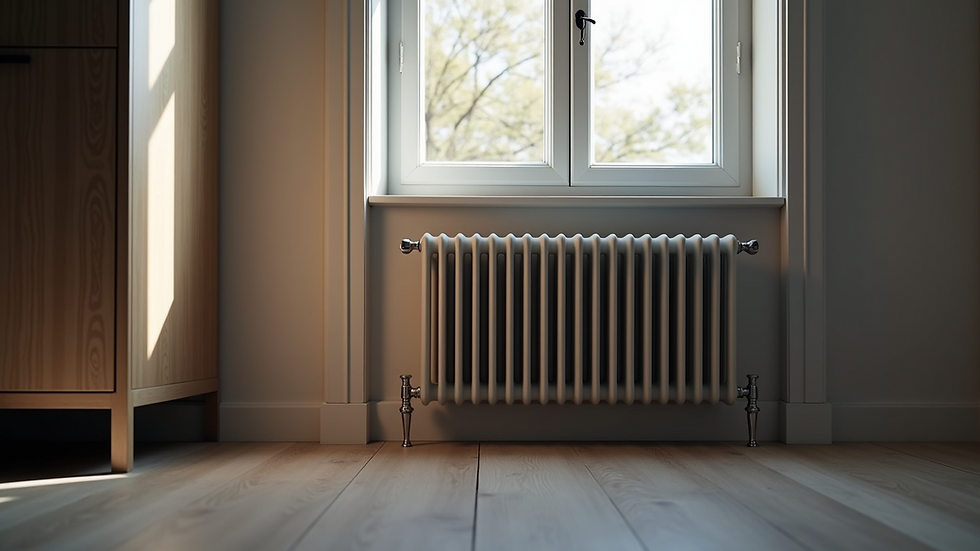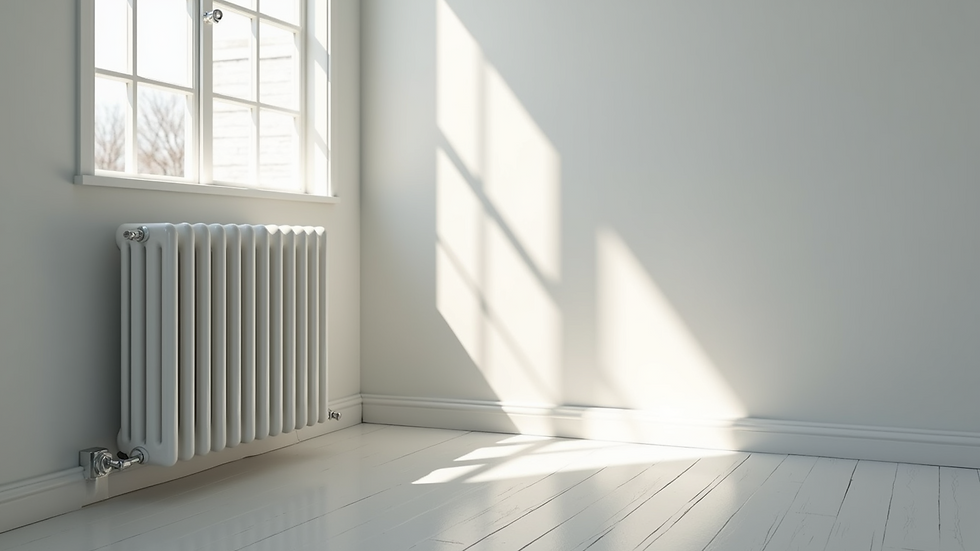How to Choose the Right Radiator Size
- Mark Spence
- 6 days ago
- 4 min read
Choosing the right radiator size is essential for maintaining a comfortable and energy-efficient home. A radiator that is too small will struggle to heat the room, while one that is too large can waste energy and money. Understanding how to calculate radiator heating requirements helps you select the perfect radiator size for your space. This guide will walk you through the key factors to consider, how to measure your room, and practical tips to ensure your heating system works efficiently.
For a full heat loss survey of your space please contact a specialist. For installation please contact your plumber or heating engineer. This is only to be used as a guide.
Why It’s Important to Calculate Radiator Heating Requirements
Selecting the correct radiator size is not just about fitting the space aesthetically. It directly impacts the heating performance and energy consumption of your home. Radiators work by transferring heat to the air in the room, and their size determines how much heat they can emit.
Energy Efficiency: A properly sized radiator uses less energy to heat the room, reducing your heating bills.
Comfort: The right size ensures even heat distribution, avoiding cold spots.
Longevity: Overworking a small radiator can cause wear and tear, shortening its lifespan.
Cost Savings: Avoid unnecessary expenses by not overspending on an oversized radiator.
By calculating radiator heating requirements, you ensure your heating system is tailored to your room’s needs, providing comfort and efficiency.

Factors to Consider When Choosing Radiator Size
Several factors influence the size of the radiator you need. Understanding these will help you make an informed decision.
Room Size and Volume
The larger the room, the more heat it requires. Measure the length, width, and height of the room to calculate its volume. This gives a baseline for the heat output needed.
Insulation Quality
Well-insulated rooms retain heat better, requiring smaller radiators. Poor insulation means more heat loss, so a larger radiator may be necessary.
Window Size and Type
Windows are a major source of heat loss. Large or single-glazed windows increase heat loss, so the radiator size should compensate for this.
Room Usage
Rooms used frequently or for long periods, like living rooms, need more heat than occasional-use rooms like storage areas.
External Walls and Exposure
Rooms with external walls or those facing cold winds lose heat faster. This factor should be included in your calculations.
Desired Room Temperature
Different rooms have different temperature requirements. For example, bathrooms may need to be warmer than bedrooms.
Radiator Type and Material
Different radiator types (panel, column, convector) and materials (steel, cast iron, aluminium) have varying heat outputs. This affects the size needed.
How do you calculate the size of a radiator required?
Calculating the size of a radiator involves determining the heat output needed, usually measured in British Thermal Units (BTUs) or Watts. Here’s a step-by-step guide:
Step 1: Measure the Room
Measure the length, width, and height of the room in metres.
Calculate the volume: Length x Width x Height.
Step 2: Calculate Heat Loss
Use a multiplier based on insulation and room features.
For example, a well-insulated room might use 40 Watts per cubic metre, while a poorly insulated room might need 60 Watts.
Step 3: Adjust for Windows and External Walls
Add extra Watts for large windows or external walls.
For example, add 10-20% more heat output for rooms with large single-glazed windows.
Step 4: Calculate Total Heat Output Needed
Multiply the room volume by the Watts per cubic metre.
Add any adjustments for windows and walls.
Step 5: Choose Radiator Size
Radiators have a heat output rating (Watts or BTUs).
Select a radiator with a heat output equal to or slightly higher than your calculated requirement.
For convenience, you can use a radiator size calculator to simplify this process and get accurate recommendations.

Practical Tips for Selecting the Right Radiator Size
Consider Multiple Radiators for Large Rooms
Instead of one large radiator, multiple smaller radiators can provide more even heat distribution.
Position Radiators Strategically
Place radiators under windows or on external walls to counteract heat loss.
Factor in Thermostatic Radiator Valves (TRVs)
TRVs allow you to control the temperature of each radiator individually, improving efficiency.
Don’t Oversize Excessively
While it’s better to have a slightly larger radiator than too small, oversizing can lead to wasted energy and higher bills.
Consult Professionals When in Doubt
Heating engineers or specialists can provide tailored advice based on your home’s specifics.
Common Mistakes to Avoid When Choosing Radiator Size
Relying on Guesswork
Estimating radiator size without measurements often leads to poor heating performance.
Ignoring Room Features
Failing to consider insulation, windows, and external walls can result in undersized radiators.
Overlooking Radiator Output Ratings
Not checking the heat output rating of radiators can cause mismatches.
Neglecting Future Changes
If you plan to improve insulation or change room usage, factor this into your radiator size choice.
Forgetting Maintenance Access
Ensure there is enough space around the radiator for cleaning and servicing.

Making the Most of Your Radiator Investment
Choosing the right radiator size is just the first step. To maximize comfort and efficiency:
Bleed your radiators regularly to remove trapped air.
Use reflective panels behind radiators on external walls to reduce heat loss.
Maintain your boiler and heating system for optimal performance.
Consider upgrading to modern radiators with better heat output and design.
By combining the right radiator size with good maintenance and smart usage, you can enjoy a warm, cosy home without overspending on energy.
Selecting the right radiator size is a straightforward process when you understand the key factors and calculations involved. Use the steps and tips outlined here to ensure your heating system meets your needs efficiently. For a quick and accurate recommendation, try the radiator size calculator and take the guesswork out of your heating decisions.


